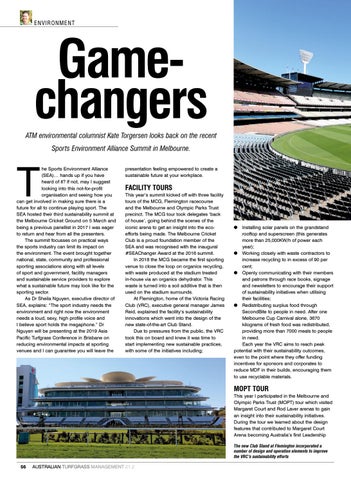ENVIRONMENT
Gamechangers Just one word needed – stunning!
ATM environmental columnist Kate Torgersen looks back on the recent Sports Environment Alliance Summit in Melbourne.
T
he Sports Environment Alliance (SEA)… hands up if you have heard of it? If not, may I suggest looking into this not-for-profit organisation and seeing how you can get involved in making sure there is a future for all to continue playing sport. The SEA hosted their third sustainability summit at the Melbourne Cricket Ground on 5 March and being a previous panellist in 2017 I was eager to return and hear from all the presenters. The summit focusses on practical ways the sports industry can limit its impact on the environment. The event brought together national, state, community and professional sporting associations along with all levels of sport and government, facility managers and sustainable service providers to explore what a sustainable future may look like for the sporting sector. As Dr Sheila Nguyen, executive director of SEA, explains: “The sport industry needs the environment and right now the environment needs a loud, sexy, high profile voice and I believe sport holds the megaphone.” Dr Nguyen will be presenting at the 2019 Asia Pacific Turfgrass Conference in Brisbane on reducing environmental impacts at sporting venues and I can guarantee you will leave the
presentation feeling empowered to create a sustainable future at your workplace.
FACILITY TOURS This year’s summit kicked off with three facility tours of the MCG, Flemington racecourse and the Melbourne and Olympic Parks Trust precinct. The MCG tour took delegates ‘back of house’, going behind the scenes of the iconic arena to get an insight into the ecoefforts being made. The Melbourne Cricket Club is a proud foundation member of the SEA and was recognised with the inaugural #SEAChanger Award at the 2016 summit. In 2018 the MCG became the first sporting venue to close the loop on organics recycling, with waste produced at the stadium treated in-house via an organics dehydrator. This waste is turned into a soil additive that is then used on the stadium surrounds. At Flemington, home of the Victoria Racing Club (VRC), executive general manager James Reid, explained the facility’s sustainability innovations which went into the design of the new state-of-the-art Club Stand. Due to pressures from the public, the VRC took this on board and knew it was time to start implementing new sustainable practices, with some of the initiatives including;
Installing solar panels on the grandstand rooftop and superscreen (this generates more than 25,000KW/h of power each year); l Working closely with waste contractors to increase recycling to in excess of 90 per cent; l Openly communicating with their members and patrons through race books, signage and newsletters to encourage their support of sustainability initiatives when utilising their facilities; l Redistributing surplus food through SecondBite to people in need. After one Melbourne Cup Carnival alone, 3670 kilograms of fresh food was redistributed, providing more than 7000 meals to people in need. Each year the VRC aims to reach peak potential with their sustainability outcomes, even to the point where they offer funding incentives for sponsors and corporates to reduce MDF in their builds, encouraging them to use recyclable materials. l
MOPT TOUR This year I participated in the Melbourne and Olympic Parks Trust (MOPT) tour which visited Margaret Court and Rod Laver arenas to gain an insight into their sustainability initiatives. During the tour we learned about the design features that contributed to Margaret Court Arena becoming Australia’s first Leadership The new Club Stand at Flemington incorporated a number of design and operation elements to improve the VRC’s sustainability efforts
56
AUSTRALIAN TURFGRASS MANAGEMENT 21.2
